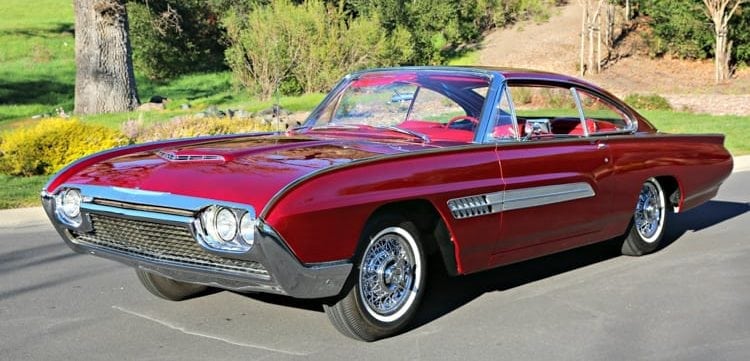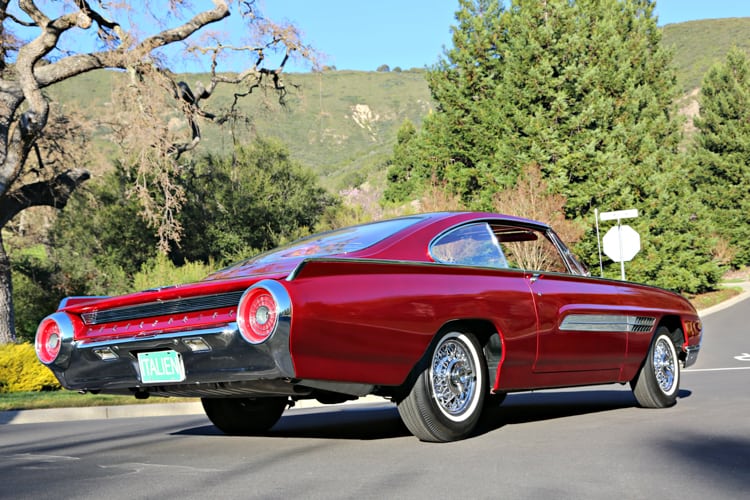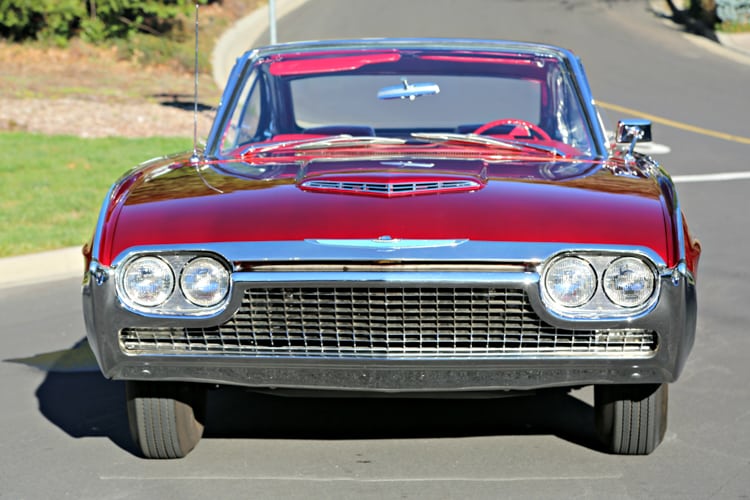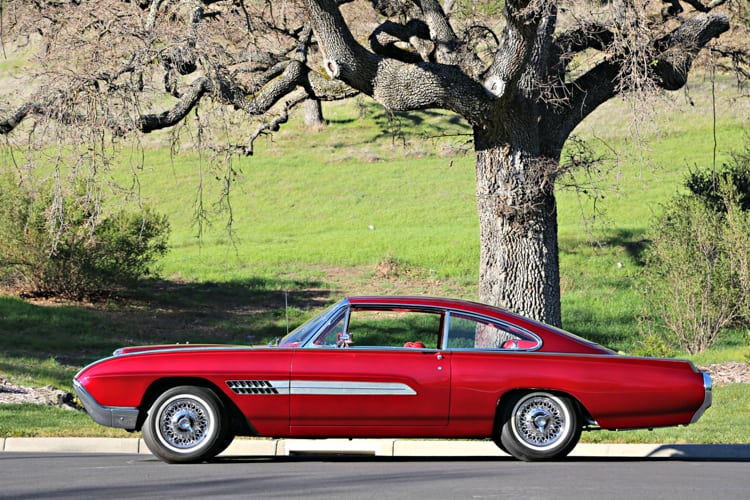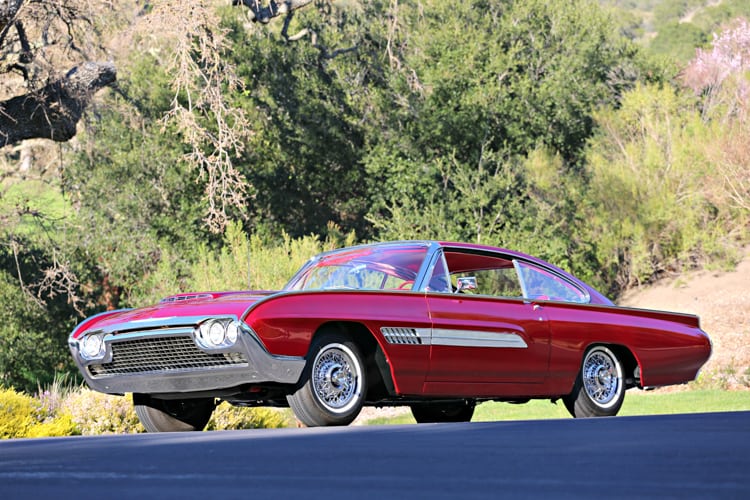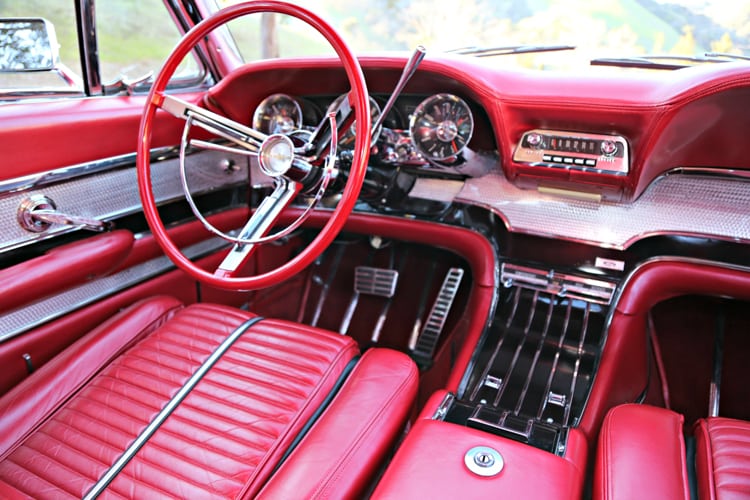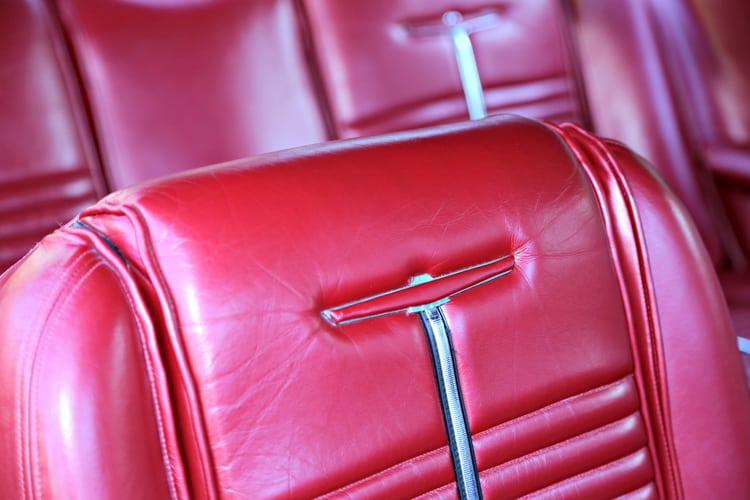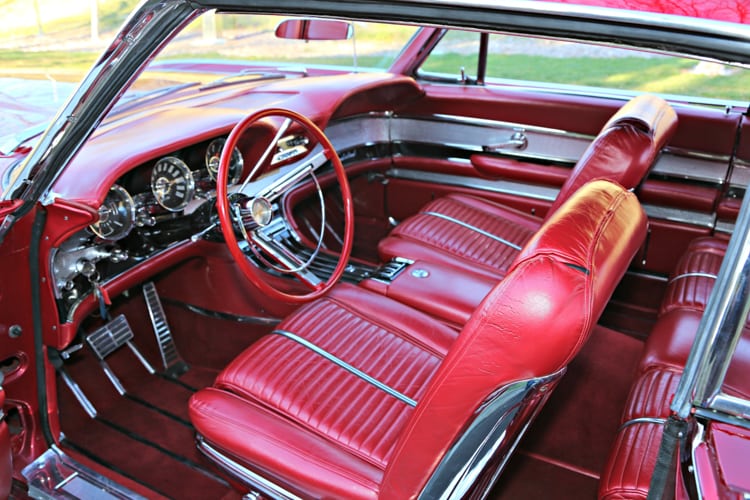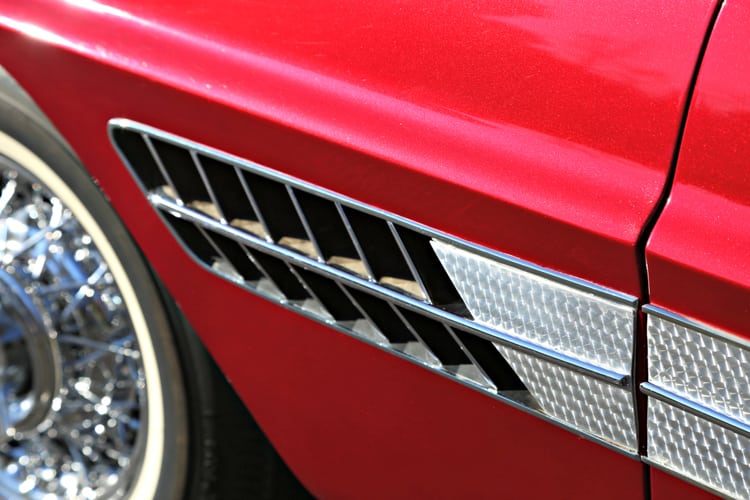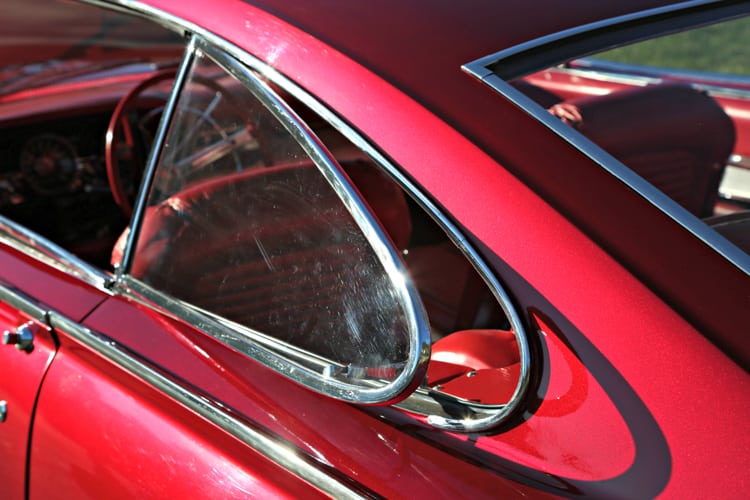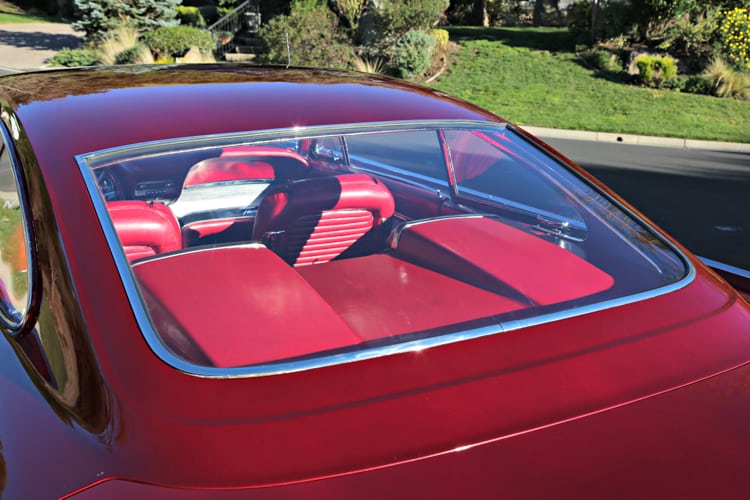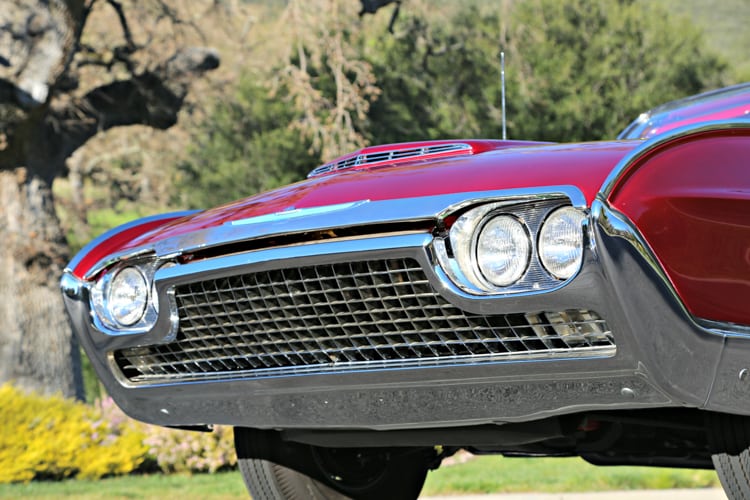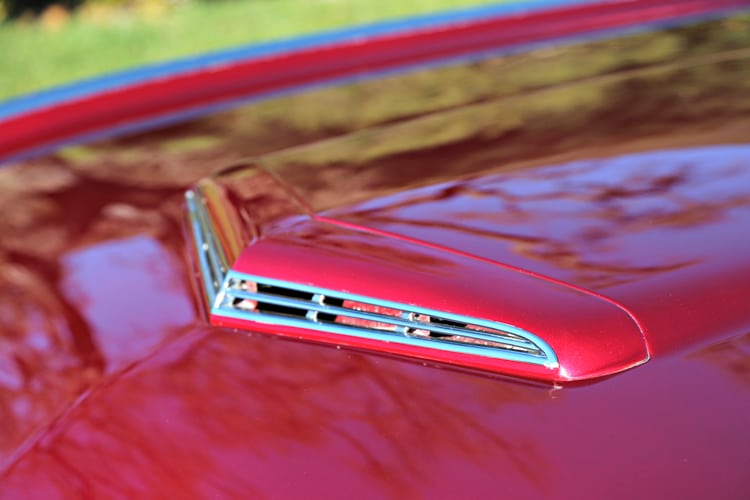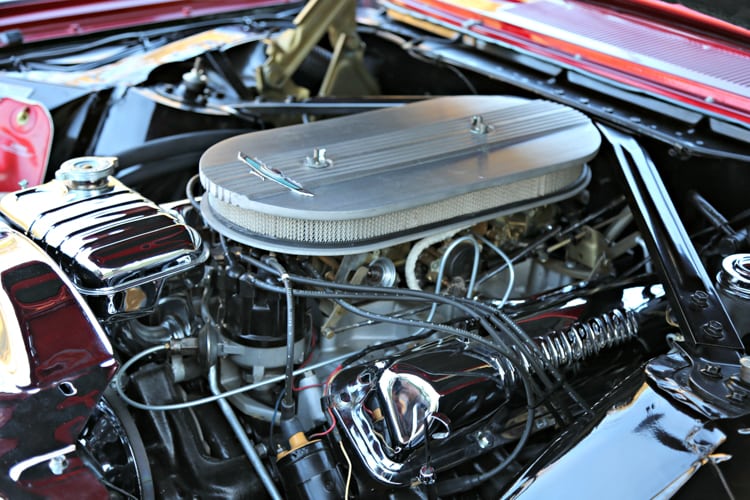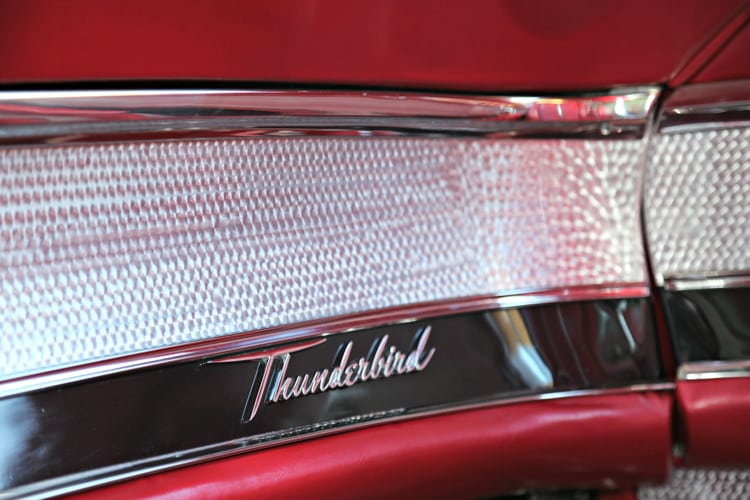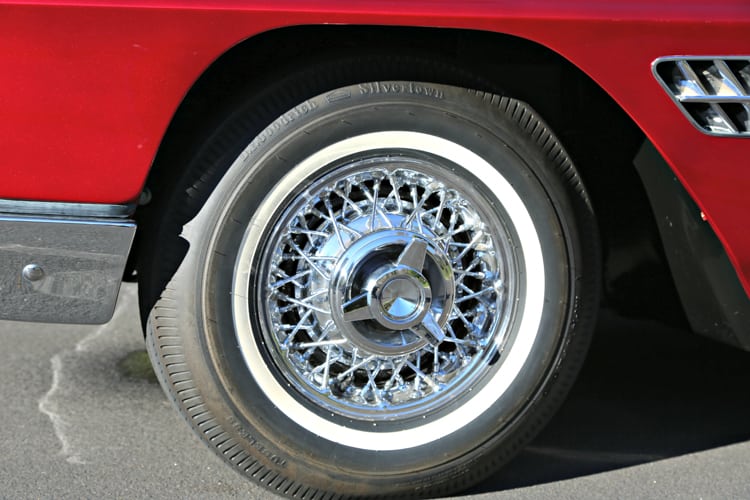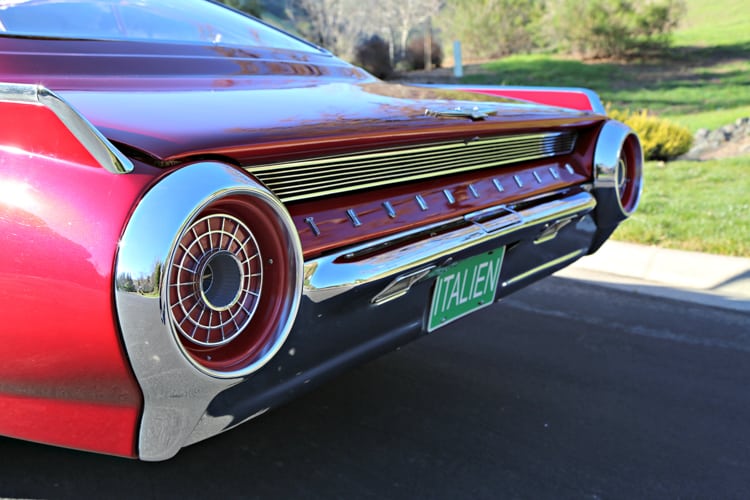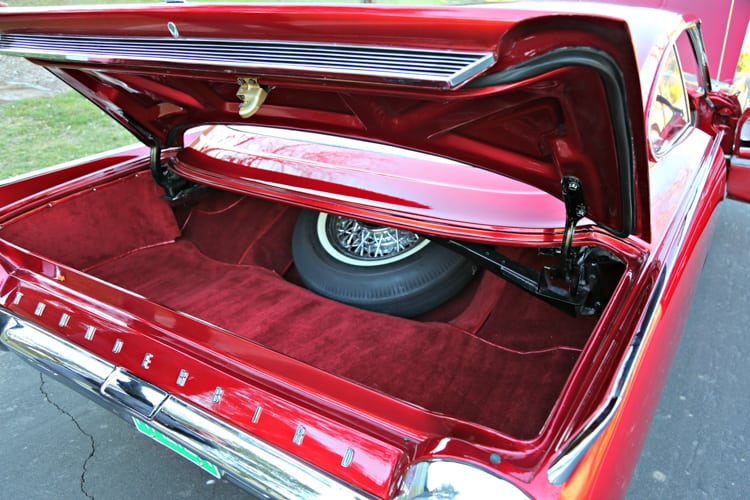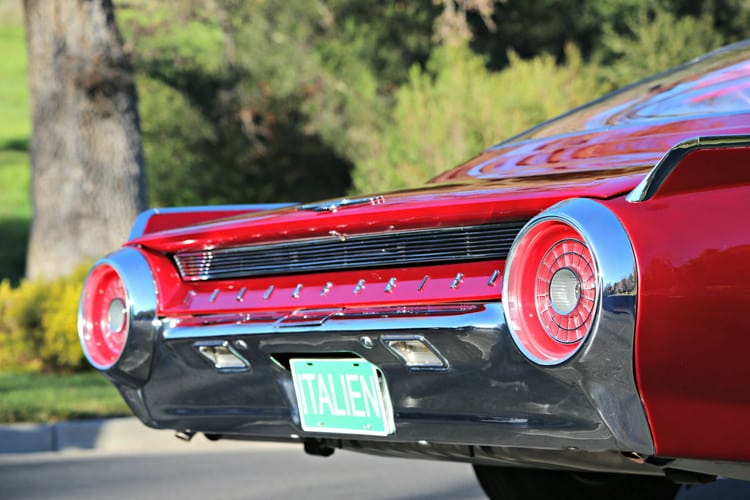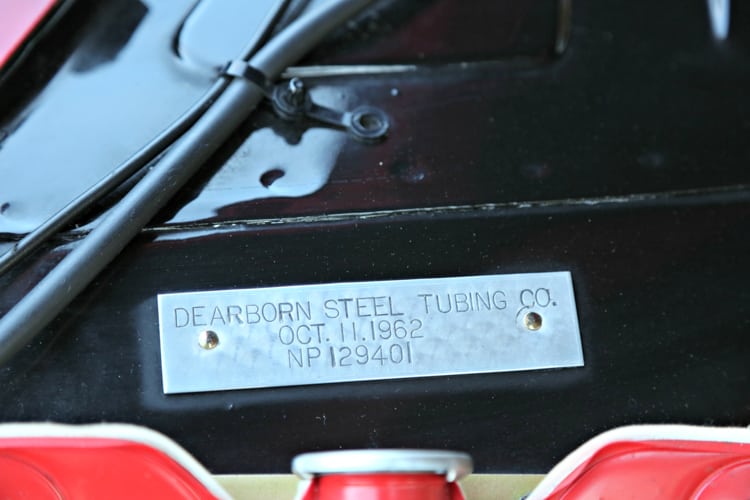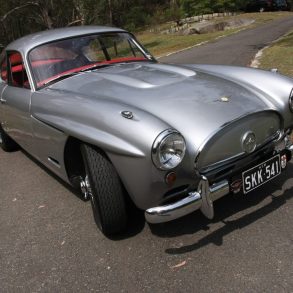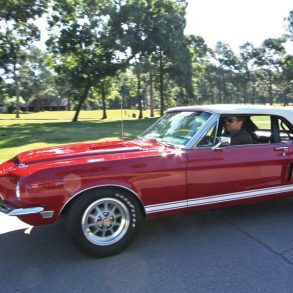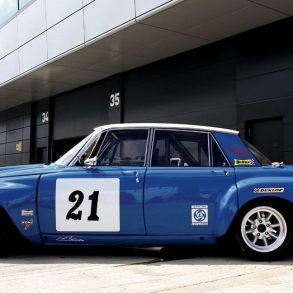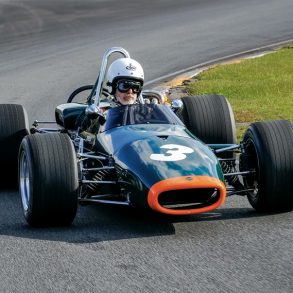If you visited a car show in 1963 or 1964, you would have seen concept cars on display from many different manufactures, just as you do today. Concept cars are built to showcase new and futuristic designs and to capture the imagination of the public. The public’s response to these concept cars often influences a car maker’s decision to implement design concepts into production cars at a later date. The Ford Italien, a Thunderbird-based, fastback concept car with an Italian flair, was one of the most popular cars on tour at the time. With its dramatic roofline, sumptuous leather interior, unique trim and eye-catching deep candy apple red paint scheme, the Italien was show stopper.
The sleek fastback roof flows gracefully into the trunk lid invoking the look of speed and excitement in contrast to the production car’s more formal roofline. The concept of a fastback roof would become a reality at Ford midway through the 1963 model year when Ford offered a less dramatic version of a fastback roof on the Galaxie, Falcon and similar Mercury models. The fastback roof would also be used on the Mustang, introduced in the Spring of 1964 with great success, starting a trend that would influence the styling of GM, AMC and Chrysler products that would last for several years. A few of the most striking examples being the AMC Marlin, the Plymouth Barracuda, and the 1967-1968 full-size Pontiac, Impala, Olds 88, Buick LeSabre and Wildcat.
A press release dated January 21, 1963, announced the Ford Custom Car Caravan for 1963 and the Italien for the first time: “LOS ANGELES – The Ford Custom Car Caravan, a special display of customized 1963 Ford models will be displayed at the Winter Nationals…February 7,8,9 and 10.” At the end of the press release the Italien is metioned: “An additional ‘custom’ unit is the Thunderbird Italien, a study in style created by the Styling Office of the Ford Motor Company.” In addition to the all the auto shows, in 1964 the Ford Custom Car Caravan, including the Italien, was featured at the 1964-1965 World’s Fair in New York. The press loved the car, and it was mentioned or featured in at least 13 magazines, including two covers, in 1963 and 1964.
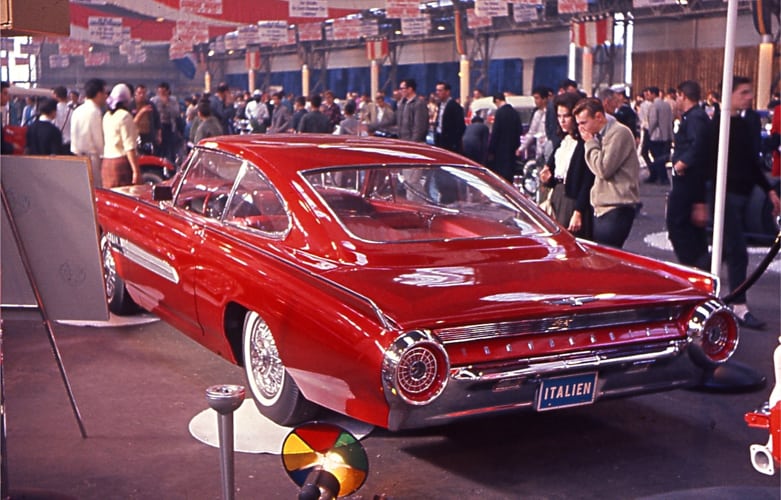
Even though the production 1961 Thunderbird was an innovative and beautiful design, Ford wanted a special concept car show version to be displayed for the 1962-1963 Ford Custom Car Caravan. Custom cars were the rage in the early ’60s, with the Detroit manufacturers creating concept and custom show cars to dazzle the public. The Ford Custom Car Caravan traveled around the U.S., setting up displays in all the major auto shows such as the ones hosted by the International Show Car Association (ISCA), as well as bringing the Caravan to county and state fairs, teen fairs, shopping malls and Ford Dealerships. Some of the cars Ford displayed at the shows in 1962 and 1963 included the Mustang II, Cougar II, Allegro, the George Barris-built Fairlane Landau Starburst, and the Italien. It is unclear why Ford named the car Italien and not Italian, however the name is custom, just like the car.
Henry Ford II, or “Hank to Duce”, was a fan of everything Italian, so he most likely endorsed the idea to create a concept car with an Italian theme. His girlfriend and future wife was Italian, and he liked Ferraris. Enzo Ferrari presented Ford with a 212 Barchetta in 1952, and its styling influenced the design of the 1955 Thunderbird. Ford negotiated with Enzo to purchase the Ferrari company in early 1963, but Enzo decided not to sell after months of talks, but that is another story…
Creating the Italien
The Italien started off as a 1962 Thunderbird convertible, however there is no ROT sheet (build sheet), factory gate release or invoice or Ford VIN number anywhere on the car, as it was intended to be strictly a design study concept car, and not intended ever to be sold to the public for use on the street. The car was sent from the factory directly to the Ford Styling shop where work began on creating a concept car.
An article published in the June 1963 issue of Speed and Custom magazine describes the work done by Ford Styling: “The basic car used as a starting point was a T-Bird convertible, a car which is already hard to improve on. After discarding the soft top, Ford Styling built a complete wooden buck over the car, approximating the shape of the new fast back. Space was then left to add an outside layer of modeling clay which was shaped to perfection, and checked with special gauges to insure symmetry. Even the windows and rear window were completed and faired in.”
After Ford Styling completed the clay shape of the roof, the car was sent to a little known subcontractor at the time, Dearborn Steel Tubing (DST). Later DST would become famous for building all the trick high-performance engine components for Ford, including tri-power intakes, cams, fuel logs, exhaust manifolds and more. DST would also go on to build the 100 legendary Fairlane Thunderbolt drag cars for Ford in 1964. At DST, the work began on transforming the clay roof mold created by the Ford stylists into fiberglass so it could be used on the car. Vince Gardner was the man at DST in charge of the Italien.
Gardner got his start building cars when he was in high school in Duluth Minnesota, winning GM’S Fisher Body Craftsman Guild award. Gordon Buehrig was impressed with Gardner’s talent and hired him to work at the Auburn Automobile Company, where he would work on the clay design of the coffin nose Cord 810. After Auburn folded, he worked at Briggs Manufacturing as a draftsman, then at Budd Manufacturing starting out as a model builder before quickly becoming chief of design. In 1943, Gardner joined Raymond Lowey at Studebaker. In 1947, he created the award winning Garner Special, a sportster created from a new 1947 Studebaker Champion. In the ’50s, he designed and built the award winning Vince Gardner Vega sports car commissioned by Ford and had plans to manufacture his own fiberglass sports car that never materialized. Gardner is also credited with the 1956 Studebaker line of passenger cars. He also worked with famous customers of the time, including George Barris. In 1962, Gardner was doing what he does best, designing and building show cars, at DST.
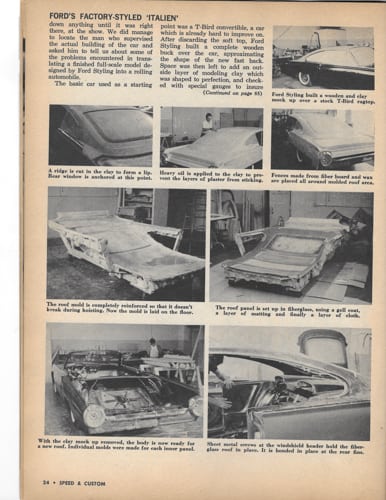
“After carefully removing these molds, Vine Gardner proceeded to make a complete mold of the roof area. Since the back window requires a mounting lip, a scraper was used all around the rear window to carve out this section. The mold now incorporates a recessed lip which does not have to be added at a later date. Similarly, a groove duplicating the drains around the trunk lid was also cut. A mold must be carefully reinforced with tubing, or two-by-fours that are embedded into it to maintain alignment. This provides a conventional hoisting place, and insures the mold against breakage or cracking.
“Ford Styling designed a remarkable set of faired in head rests for the rear seat passengers, and we’ll eat our hat if this doesn’t start a new trend in the customizing field. Part of the work involved in making a complete panel extending between the fins of the rear fender panels. The roof is bonded and fastened with sheet metal screws to the fender panels. The junction point is covered with a chrome cap molding. This way, the fiberglass is not joined to the metal anywhere in the midst of a panel, and there is no chance of cracks occurring.”
The article also describes some of the custom made fiberglass interior parts as well: “Many additional parts had to be made up in fiberglass to complete the job. We’ll start with the interior panels that fair in the rear seats and cover the inside of the quarter panels. All of the interior moldings running along the edge of the roof were made up in clay by Ford Styling, then duplicated by Vince’s department, and finally chrome plated. Fiberglass is admittedly hard to chrome, but this is considerably less costly than attempting white metal moldings on a one-of-a-kind basis.”
Photos from the magazine article of the car under construction clearly show it with 1962 fenders and doors, but at some point Ford delivered 1963 fenders and doors to DTS for use on the car. Other interesting and unique features on the Italien include a custom made egg crate grill designed by Ford and crafted by DST from 1/8” thick brass, then painstakingly dovetail fitted together creating a look not unlike a Ferrari grill. The front bumper guard used on the production was deleted, and the turn signals are partially concealed behind the grill. The special hood molding is made of fiberglass and chrome plated. Special fender side vents flare beautifully into custom crafted, engine-turned metal side trim that extend far into the doors. In addition to the roof and trunk lid, the quarter panels are modified as well. The rear wheel openings are reshaped to better match the front wheel openings and the quarter panels are extended to fill the gap where the production car has a rubber filler between the bumper and the body. The custom styled trunk lid has a special chrome grill and “THUNDERBIRD” individual lettering, plus special tail light lenses. The body is painted a deep candy apple red.
The interior is customized with engine turned trim on the dash and door panels that match the exterior side trim, and has a modified console with just two window switches instead of four. The quarter glass on the Italien are front hinged, rear pop-out type, very European. The seats are elaborately pleated, and are luxuriously upholstered in candy apple leather. The headliner, dash, kick panels, seat skirts and custom fabricated rear package tray are also covered in leather. The floors are fitted with bright metal scuff strips.
Under the hood of the Italien is a 390 CID V-8 engine fitted with a rare 3X2 barrel intake and carburetor system with finned cast aluminum air cleaner used on M-code production cars. It has a chrome dress up kit (chrome Thunderbird script valve covers, expansion tank, master cylinder cover, power steering reservoir cover and oil filter cover), plus the fan, fan pulley and fan guard are chromed.
Overall, there are at least 80 differences from the production Thunderbird, both big and small, that can be found on the Italien inside and out.
The Italien steps away from the spotlight
As with many manufacturers’ experimental, concept and special show cars, it was common practice to destroy these cars when the factory was done with them, as they were considered hard to warranty, service, and possibly unsafe, having been built just for show only. An internal Ford Motor Company letter, dated July 31, 1965, signed by Special Promotion Manager Jacque Passino, lists the Italien as one of the cars slated to be scrapped. Somehow the Italien was pardoned by Passino and subsequently sold to DST on September 22, 1964, for the sum of $5,000, according to Ford documents.
DST then immediately sold the car to movie and television actor Dale Robertson. It is unclear if Robertson purchased the car (one source says he paid $10,000 for it), or if it was gifted to him. There is a hand written and signed note from Robertson stating it waspresentedto him by Ford. Dale Robertson appeared in many western movies and played Jim Hardie on the TV series “Tales of the West” and was guest star on other TV Westerns in the 1950s and 1960s including “Wagon Train” and later played JJ Starbuck on the TV series of the same name. Robertson had previously received a special factory show car when he was gifted a new 1958 Buick Limited convertible by GM, modified in a Wells Fargo western theme.
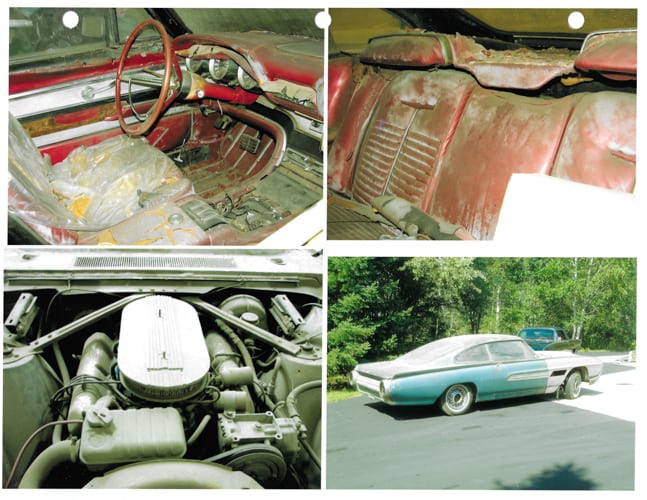
Robertson kept the Italien in Southern California until 1965, when he passed it on to his gardener, William Warner. Records show Warner registered the car in 1967, then sold it to Joe Navaro, an Insurance salesman in 1974. Navaro brought the Italien to a local body shop in 1975 and had it repainted metallic blue, then used it in his insurance business travels around the Los Angeles area. Don Chambers, a noted Ford collector and operator of a local Mustang parts business recognized the Italien when he saw it on the street one day. Chambers attempted to buy the Italien from Navaro for years but to no avail. It is said that Chambers even offered to trade him a motel he owned, named the Thunderbird Motel for the car, but Navaro still said no. Finally, in the late 1980s, Chambers was able to acquire the car and register it in his name in March, 1989. By then the car was intact but weathered, sun baked by the California sun. Chambers held on to the concept car until 2005, placing an ad in Hemmings Motor News, when he decided to sell it due to health reasons.
The restoration and return to greatness
In October of 2005, Tom Maruska saw the ad in Hemmings Motor News. Maruska was very familiar with the 1961-1963 “Bullet Birds” and had restored 15 convertibles by then, including a rare M-series Sport Roadster. For a Bullet Bird enthusiast, this is the Holy Grail of collectibles. Maruska recalls, “As with most Thunderbird enthusiasts, I had heard of the Italien but I had no idea it existed.” After traveling to Los Angeles from his home in Duluth, Minnesota, a deal was made and the Italien was shipped back to Maruska’s shop, arriving on February 19, 2006.
Fortunately, the Italien spent its whole life in Southern California, and the body was not rusty or badly damaged. The car was complete with the exception of the hood lip molding. According to Maruska, “The story goes that somewhere in the past, the piece was removed by a repairman and kept as collateral because the owner at the time, most likely Dale Robertson’s gardener, didn’t have the funds available to pay for the repairs.” The molding was made of fiberglass, then chrome plated, and unique to the car. The molding was discovered at a shop in Los Angeles, but the owner wanted the sum of $10,000 just for the molding, so Maruska passed, crafting his own perfect replica to exact standards. Maruska completely disassembled the car and started the restoration in October of 2006 with the goal of returning it to like-new show condition, just as it was in 1962. The process of painting a car with a deep candy apple paint job required many coats of paint in 1962. Maskura found no less than 72 coats of candy apple on the car, plus several coats of blue that required six applications of aircraft stripper to get down to the bare metal and fiberglass. All the trim parts were scored, requiring countless hours recreating the engine turned metal trim exterior and interior parts, one small round swirl at a time for a total of 3,840 individual “turns”. Maruska even did the upholstery himself on a sewing machine purchased on eBay that he says was the same age as the car. The Plexiglas rear glass and quarter windows were sent out to a specialist and came back looking flawless. Maruska is a perfectionist, and it shows in the quality and authenticity of the restoration he performed. Every nut and bolt of the car was restored to factory specifications, and by August of 2007, the Italien was finished.
Maruska consigned the Italien to the Barrett Jackson auction in Scottsdale, Arizona, in January of 2008. Factory concept cars rarely come up for sale and an astute collector happily purchased it when it came up on the block. It has been on display at the prestigious Blackhawk Automobile Museum since then where the Italien is still dazzling the public, just as it did over 50 years ago.


